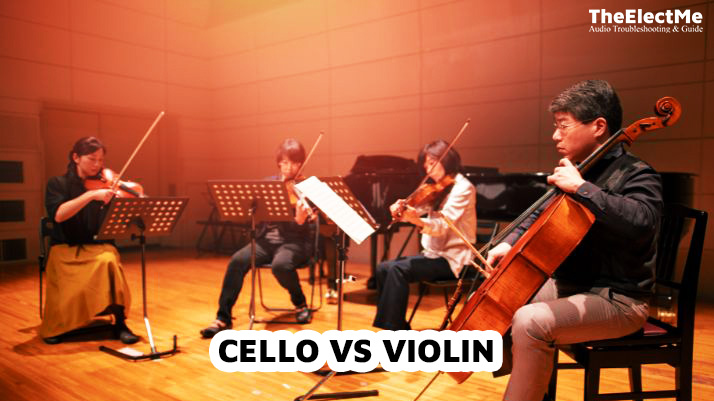Here’s a peek into the world of music, focusing on two stars of the show – the cello and the violin. Both members of the string instrument family boast rich histories and unique allure. But they’re also quite different. This deep dive matters for budding musicians choosing an instrument and music fans looking to learn more.

The goal? To give a full picture of both the cello and violin, highlighting how they’re alike and how they’re not while making your journey through music even richer.
Cello Vs Violin: Understanding The Basics
The violin, a star in the string instrument family, stands out with its small size and high pitch. It’s often seen cradled under the musician’s chin, played with a bow gliding across four strings.
Made mostly from wood, violins come with a curved body, a neck for holding, and a scroll at the top.
The sound of a violin can range from soft and sweet to loud and piercing, depending on how it’s played.
Now, let’s meet the cello. It’s a larger sibling to the violin, offering a deeper, richer sound. To play the cello, musicians sit down and hold it between their knees. Like the violin, the cello is carved from wood and features four strings.
But its size gives it a broader range of notes. Its sound can be warm and mellow or powerful and commanding. The cello holds a special place in the hearts of many music lovers.
Physical Differences Between Cello And Violin
Here are some clear differences that set the cello and violin apart.
Size and Portability
The most evident physical difference between the cello and violin is their size. The violin, the smaller of the two, is more portable and easier to carry around. It typically measures about 24 inches in length. On the other hand, the cello stands taller at about 48 inches. This larger size makes the cello less convenient for travel.
Playing Position
The way each instrument in a band is played also differs. The violin is held under the chin and played while standing or sitting. In contrast, the cello is played seated, with the instrument resting on the floor, held securely between the player’s knees.
Furthermore, the violin is hard to learn and requires a lot of practice to master. On the other hand, the cello is slightly easier to learn compared to the violin but still requires time and dedication to become proficient.
Learning Curve: Cello vs Violin
Do you know what set-up takes longer? Learning cello and violin requires specific techniques, skills, and postures. It’s a process that can take years to master.
Here’s why.
Difficulty Level for Beginners
When it comes to learning, both instruments are inherently challenging. Both have their challenges. The smaller violin might seem less daunting, but it requires precise finger placement due to its shorter strings. Meanwhile, the larger cello can be intimidating, but its longer strings offer more leeway for finger placement.
Posture Requirements
Both instruments demand good posture. Violinists must maintain a steady yet relaxed hold on their instrument without straining their neck or shoulders. Cellists must sit straight and balance the weight of the cello between their knees while maintaining a comfortable grip on the bow. Each presents its unique physical demands, requiring strength and flexibility.

Sound And Music: Violin Vs Cello
Sound and music are the most critical elements when comparing two musical instruments. Below, we’ll delve into the distinct sound qualities of the cello and violin, along with how they’re used in various musical genres.
Sound Quality and Range
In terms of sound, the violin produces a bright, high-pitched tone, while the cello offers a deeper, mellow sound. The violin’s range extends from G below middle C up to the highest E on the piano.
Conversely, the cello has a lower range, starting from C two octaves below middle C and reaching up to A above middle C. Both instruments are versatile and capable of producing various tones and expressions.
Role in an Ensemble
In an ensemble, both instruments have their unique roles. The violin often takes the lead, playing the melody in many pieces due to its high pitch. With its deeper tone, the cello commonly provides harmony and rhythmic support. It can also be spotlighted, especially in string quartets or solo performances.
Cost Comparison: Cello Vs Violin
The cost of these instruments can vary widely based on factors like craftsmanship, materials used, and brand reputation. Generally, violins are less expensive due to their smaller size and less required material.
You can expect to pay anywhere from $100 for a beginner’s violin to thousands of dollars for a professional-grade instrument.
Cellos, being larger and more material-intensive, typically start at a few hundred dollars for beginner models and can go up to tens of thousands for high-quality professional instruments.
Popularity and Demand: Violin vs Cello
When it comes to popularity, the violin often takes center stage. It is widely recognized and played by more musicians than the cello. This popularity, however, also means that competition is high among violinists, especially for higher-ranking spots in ensembles.
On the other hand, fewer students study the cello, making cellists usually in higher demand. The recent mainstream popularity of the cello has also increased its visibility, leading to more opportunities for cellists to shine in solo performances and ensemble pieces.
Both instruments have diverse repertoires and are used widely across different music genres. They each have their iconic pieces tailored to their unique voices. For the violin, think of Vivaldi’s “Four Seasons,” for the cello, consider Elgar’s “Cello Concerto”.
Conclusion – Cello vs Violin
In conclusion, the violin and cello have unique attributes that make them appealing. The violin is smaller, more portable, and has a higher pitch, while the cello is larger, produces a deeper tone, and requires a seated playing position.
Both instruments require dedication to master, with distinct challenges regarding posture and finger placement. Violins typically lead with the melody in an ensemble, while cellos offer harmonious support. While violins are generally more popular, cellists are often in high demand due to lower competition.
When choosing between the two, consider your physical comfort, sound preference, budget, and the role you wish to play in music. Your circumstances and preferences will guide you to the right choice.



